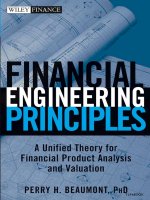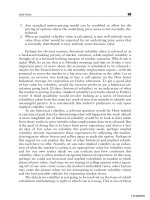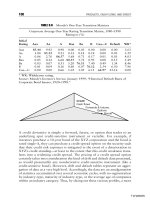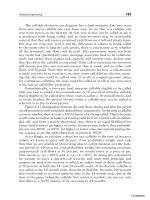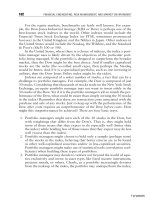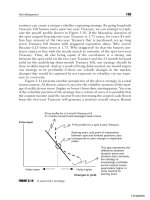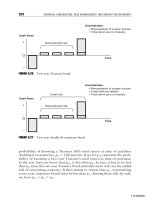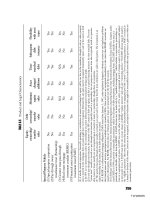Test bank for financial reporting financial statement analysis and valuation 8th edition
Bạn đang xem bản rút gọn của tài liệu. Xem và tải ngay bản đầy đủ của tài liệu tại đây (64.94 KB, 14 trang )
Test Bank for Financial Reporting Financial Statement
Analysis and Valuation 8th Edition
by Wahlen Multiple Choice Questions
Assets for a particular business might include
1.
a.Cash, retained earnings, and accounts payable.
2.
b.Cash, common shareholders’ equity, and accounts receivable.
3.
c.Cash, property, plant, and equipment, and accumulated other
comprehensive income.
4.
d.Cash, inventories, and goodwill.
Which of these would be considered Property, Plant, and
Equipment?
1.
a.Trademark
2.
b.Office Building
3.
c.Factory Building
4.
d.Goodwill
Why is the operating activities section of the statement of cash
flows often believed to be the most important part of the
statement?
1.
a.Because it shows the dividends that have been paid to stockholders.
2.
b.Because it indicates a company's ability to generate cash from sales to
meet current cash payments for goods or services.
3.
c.Because shows the net increase or decrease in cash during the period.
4.
d.Because it gives the most information about how operations have been
financed.
Which financial statement for a business would you look at to
determine the company's earnings performance during an
accounting period?
1.
a.Balance sheet.
2.
b.Income statement.
3.
c.Statement of cash flows.
4.
d.The Management Assessment.
All of the following are reasons that pharmaceutical companies
have higher barriers for entry than grocery stores except:
1.
a.There is lengthy government testing and approval required.
2.
b.Research and development is a lengthy and uncertain process.
3.
c.Patent protection is needed for exclusive rights.
4.
d.The largest asset is typically capital intensive Property, Plant and
Equipment.
Which SEC form may be the best place to start learning about the
economics of an industry and the particular strategy a firm has
selected for competing in the industry?
1.
a.Form 8K
2.
b.Form 10K
3.
c.Form MD&A
4.
d.Form FSAP
Which of the following activities is an operating activity?
1.
a.Collections of accounts receivable.
2.
b.Investing in equity securities of other companies.
3.
c.Payment of dividends.
4.
d.Issuing common stock
On a common size basis, which of the following assets is
normally largest for a commercial bank?
1.
a.Accounts and Notes Receivable
2.
b.Inventory
3.
c.Property, Plant and Equipment
4.
d.Cash and Marketable Securities
Which of the following would not appear as a liability on the
balance sheet?
1.
a.A labor contract
2.
b.A note due to a bank
3.
c.Salary due employees at yearend
4.
d.Accounts payable
An example of an intangible asset is
1.
a.A patent
2.
b.Land
3.
c.Investment in another company
4.
d.Raw material inventory
Which of the following is not considered to be a liability?
1.
a.Wages payable.
2.
b.Accounts payable.
3.
c.Notes payable.
4.
d.Cost of goods sold.
A value chain for an industry sets forth
1.
a.The layers of management the needed to be successful
2.
b.Sequence of activities involved in the creation, manufacture, and
distribution of its products.
3.
c.Sequence of activities involved in a firm's research and development
activities.
4.
d.Whether the industry is horizontally or vertically integrated.
Current assets are defined as
1.
a.Cash and cash equivalents.
2.
b.All assets expected to be quickly used by the firm.
3.
c.Cash and other assets that the firm expects to sell or consume during the
normal operating cycle of a business, usually one year.
4.
d.Cash and other assets that the firm expects maintain for a period
including the normal operating cycle of a business, usually one year.
Which of the following is not one of Porter’s five forces?
1.
a.Buyer Power
2.
b.Supplier Power
3.
c.Threat of Regulation
4.
d.Threat of Substitutes
On the statement of cash flows, depreciation would be classified
as?
1.
a.A financing activity.
2.
b.An operating activity.
3.
c.An investing activity.
4.
d.A noncash activity.
Which of the following economic characteristics is consistent with
a commercial bank?
1.
a.Low barriers to entry.
2.
b.High levels of research and development.
3.
c.Low profit margin on lending activities.
4.
d.Low profit margin on feebased financial services, such as merger
consulting.
Extraordinary gains and losses arise from events that have all the
following characteristics except:
1.
a.They are unusual given the nature of the firm’s activity.
2.
b.They are nonrecurring.
3.
c.They are material in amount.
4.
d.They result from terminated involvement in a line of business.
Accounts payable represent:
1.
a.Amounts which are due to stockholders.
2.
b.Amounts which have been borrowed to finance operations.
3.
c.Amounts which are owed to the company by its customers resulting from
credit sales.
4.
d.Amounts which are owed by the company to its suppliers for past
purchases.
Which forces typically represent vertical competition in a value
chain?
1.
a.Potential entry and substitutes.
2.
b.Buyer power and rivalry among existing firms
3.
c.Supplier power and potential entry.
4.
d.Buyer power and supplier power
Which two organizations are working together to harmonize
financial reporting worldwide?
1.
a.FASB and IASB
2.
b.GAAP and FASB
3.
c.SEC and FASB
4.
d.EU and SEC
All of the following are principal provisions of the SarbanesOxley
Act of 2002 except:
1.
a.At least one member of the audit committee of the board of directors must
be a “financial expert.”
2.
b.The lead audit or coordinating partner and the reviewing partner of the
public accounting firm must rotate, or change, every five years.
3.
c.The firm’s chief executive officer and the chief financial officer must issue
a statement along with the audit report stating that the financial statements
and notes fairly present the operations and financial position of the firm.
4.
d.The FASB has oversight and enforcement authority over the SEC.
Which forces typically represent horizontal competition in a value
chain?
1.
a.Rivalry among existing firms and supplier power.
2.
b.Potential entry and buyer power.
3.
c.Substitutes and potential entry.
4.
d.Buyer power and supplier power.
Which of the following assets would appear on the balance sheet
at an amount greatly below its fair market value?
1.
a.Inventory
2.
b.Marketable securities
3.
c.Equipment
4.
d.Brand name
The accrual basis of accounting recognizes
1.
a.Revenue when cash is received from customers
2.
b.Expenses when paid
3.
c.Revenue when all or a substantial portion is performed
4.
d.Revenue when contracts are signed
The primary purpose of the balance sheet is to:
1.
a.Report the current value of the business.
2.
b.Measure the net income of a business up to a particular point in time.
3.
c.Report the difference between cash inflows and cash outflows for the
period.
4.
d.Report the financial position of the reporting entity at a particular point in
time.
Opinions on the effectiveness of the internal control system and
the fairness of the amounts reported in the financial statements
are known as:
1.
a.Management Discussion and Analysis.
2.
b.Assurance Opinions.
3.
c.Notes to the Financial Statements
4.
d.Management Assessments.
When a firm attempting to create unique products or services for
particular market niches, in order to achieve relatively high profit
margins, this is best known as
1.
a.A quality strategy
2.
b.A lowcost leadership strategy
3.
c.A vertical integration strategy
4.
d.A product differentiation strategy
The two categories of shareholders' equity usually found on the
balance sheet of a corporation are
1.
a.Contributed capital and property, plant, and equipment.
2.
b.Retained earnings and notes payable.
3.
c.Common stock and retained earnings.
4.
d.Contributed capital and equity securities.
Which form does the balance sheet equation take in the United
Kingdom?
1.
a.Noncurrent Assets + Noncurrent Liabilities = Shareholders’ Equity
2.
b.Revenues Expenses = Shareholders’ Equity
3.
c.Noncurrent Assets + [Current assets Current Liabilities] Noncurrent
Liabilities = Shareholders’ Equity
4.
d.Noncurrent Assets Current assets = Noncurrent Liabilities Current
Liabilities + Shareholders’ Equity
Which of the following economic characteristics is consistent with
a grocery store chain?
1.
a.Low barriers to entry.
2.
b.High levels of research and development.
3.
c.High profit margins.
4.
d.Low capital intensity.
The second step in financial statement analysis is to identify the
company strategy. Which of the following is a question an analyst
should ask when performing a strategy analysis?
1.
a.Are industry sales growing rapidly or slowly?
2.
b.Do earnings include revenues that appear mismatched with the business
model employed by the firm?
3.
c.Does the industry include a large number of firms selling similar products?
4.
d.What is the company’s degree of geographical diversification?
On a common size basis, which of the following assets is
normally largest for an electric utility?
1.
a.Accounts receivable
2.
b.Inventory
3.
c.Property, Plant and Equipment
4.
d.Cash and Marketable Securities
Net income is equal to:
1.
a.Assets minus Liabilities
2.
b.Revenues and Gains minus Expenses and Losses
3.
c.Shareholders’ Equity minus Assets
4.
d.Revenues and Assets minus Expenses and Liabilities
The tools for studying industry economics does not include
1.
a.Value chain analysis
2.
b.Classification using Porter’s five forces
3.
c.Classification of cash flows
4.
d.Economic attributes framework
What is the principal activity of security analysts?
1.
a.To assign credit ratings.
2.
b.To apply IFRS adjustments.
3.
c.To value firms.
4.
d.To assess the need for audits.
All of the following are the building blocks for financial statement
analysis except:
1.
a.Targeting growth opportunities that diversify exchange rates, risk
exposure, and political uncertainty.
2.
b.Describing strategies that a firm pursues to differentiate itself from
competitors in order to evaluate competitive advantages, sustainability of the
firm’s earnings, and its risks.
3.
c.Evaluating the financial statements, including the accounting concepts
and methods that underlie them and the quality of the information they
provide.
4.
d.Identification of the economic characteristics of the industries and the
relation of those economic characteristics to the various financial statement
ratios.
Which financial statement would you look at to determine whether
a company will be able to pay for the goods when payment is due
in 30 days?
1.
a.Statement of cash flows.
2.
b.Statement of stockholders’ equity.
3.
c.Income statement.
4.
d.Balance sheet.
Which of the following would not inhibit new entrants into a
market?
1.
a.Existing technological expertise.
2.
b.Large required capital investment.
3.
c.Lack of rivalry among current participants.
4.
d.Existing patented technology.
Which of the following is not a characteristic of an extraordinary
item?
1.
a.Material in amount.
2.
b.Nonrecurring.
3.
c.Unusual given the nature of the firm’s activities.
4.
d.Requires a cash outflow.
Which of the following is not an activity reported in the Statement
of cash Flows?
1.
a.Operating
2.
b.Investing
3.
c.Manufacturing
4.
d.Financing
When attempting to identify the economic characteristics of the
industry in which a particular firm participates an analyst might
ask which of the following questions?
1.
a.Does technological change play an important role in the firm maintaining
a competitive advantage?
2.
b.Has the firm diversified across several geographic markets?
3.
c.Has the firm recognized revenues at the proper time?
4.
d.Has the firm structured transactions to make it look more profitable than
economic conditions suggest?
Which of the following economic characteristics is consistent with
a grocery store chain?
1.
a.Minimal competition
2.
b.Extensive competition
3.
c.High net income to sales
4.
d.Differentiated product
When assessing buyer power using Porter’s five forces, which of
the following is not consistent with low buyer power?
1.
a.Brand loyalty
2.
b.Control of distribution channel
3.
c.Large number of suppliers
4.
d.Low price
Which of the following economic characteristics is consistent with
a pharmaceutical company?
1.
a.Low barriers to entry.
2.
b.High levels of research and development.
3.
c.Low profit margins.
4.
d.Low business risk.
Which of the following is not an expense of a business?
1.
a.Depreciation
2.
b.Dividends
3.
c.Salaries
4.
d.Advertising
Which of the following is an independent entity comprising 15
members and a fulltime professional staff that specifies
acceptable accounting principles known as IFRS?
1.
a.FASB
2.
b.IASB
3.
c.SEC
4.
d.GAAP
Which of the following is a question an analyst would ask when
assessing the quality of a firm’s financial statements?
1.
a.Are the company’s products designed to meet a specific market
segment?
2.
b.Has the firm integrated forward into retailing to final consumers?
3.
c.Is the firm diversified across several geographical markets?
4.
d.Do earnings include nonrecurring gains or losses?
The cash basis method of accounting can be best described as:
1.
a.The recording of transactions and adjustments so that debits equal
credits.
2.
b.The method that equates assets with liabilities and owners’ equity.
3.
c.The method that recognizes revenue when money is received and
expenses when money is paid.
4.
d.The method that matches incurred expenses with related revenues when
they are earned.
The third step in financial statement analysis is to assess the
quality of the firm’s financial statements. Which of the following is
a question an analyst should ask when performing this step?
1.
a.Are industry sales growing rapidly or slowly?
2.
b.Do earnings include revenues that appear mismatched with the business
model employed by the firm?
3.
c.Does the industry include a large number of firms selling similar products?
4.
d.What is the company’s degree of geographical diversification?
